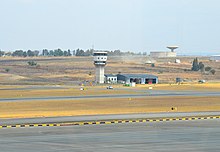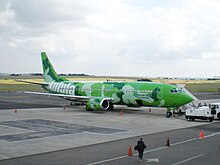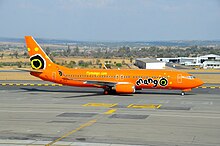Lanseria International Airport
| Lanseria International | |
|---|---|

|
|
| Characteristics | |
| ICAO code | FALA |
| IATA code | HLA |
| Coordinates | |
| Height above MSL | 1377 m (4518 ft ) |
| Transport links | |
| Distance from the city center | 40 km northwest of Johannesburg, 35 km southwest of Pretoria |
| Street | R512 |
| Basic data | |
| opening | August 16, 1974 |
| operator |
Lanseria International Airport (Pty) Ltd (1991/001749/07)
and Lanseria Airport 1993 (Pty) Ltd (1993/004101/07) |
| Passengers | 160,000 (2003) 150,000 (2005) , 1,000,000 (2010) |
| Employees | 106 (almost 200 after) |
| Runways | |
| 06R / 24L | 1524 m × 23 m asphalt |
| 06L / 24R | 3048 m × 30 m asphalt |
The Lanseria International Airport ( IATA code HLA , ICAO code FALA ) is located in the north of the metropolitan municipality City of Johannesburg . It is the smaller of the city's two airports and the only privately owned international airport in South Africa . It has existed since 1974. The operator is Lanseria International Airport Ltd. and Lanseria Airport 1993 Ltd.
Location and traffic
The airport is located in a rural area of the Greater Johannesburg region in the Lanseria district and a few kilometers from the towns of Randburg and Midrand . The main traffic connection is the regional road R512, here called Pelindaba Road . As a result of the increased number of passengers, after a renovation of the R512, a two-lane expansion of its lanes from the junction with the national road N14 is now being considered.
Airlines and Destinations
The airport is served by three national airlines (as of February): the state-owned Mango as well as the private Kulula and FlySafair . Mango announced its withdrawal at the end of March 2020 [obsolete] .
Lanseria (as of February 2020) offers daily flights to Cape Town and Durban as well as Port Elizabeth . There are flights to Zanzibar Airport in Tanzania once a week .
history
Construction of the airport began in 1974 with an investment volume of 2.7 million Rand . The idea for its location was propagated by two pilots from Pretoria , Fanie Haacke and Abe Sher, in the 1970s. According to the ideas in the founding phase, it was to become the busiest airport in the country. Protest actions against this project were formed from among the affected farmland owners. On June 6, 1972, the Minister of Planning , JJ Loots, declared the need to build this facility. The municipalities of Roodepoort and Krugersdorp as well as the Transvaal Peri-Urban Board bought the required space, which they rented to the specially founded Lanseria Management Company for a period of 99 years.
The opening for the public took place on August 16, 1974 during a ceremony with the then Transport Minister Hannes Rall. The first aircraft to land was a Learjet (ZS-MTD).
In the following year after its opening, the airport was the venue for Air Africa International '75 , a trade fair for the international aerospace sector and an important event in South African aviation history. For the first time, South African buyers in their own country were able to choose from the latest international aviation technology and electronic equipment offers. Flight demonstrations, which were originally only shown in Farnborough and Paris , were shown here.
As a result of this successful aviation fair, the Aviation Africa Show was held in October 1977 with an exhibited value of 100 million rand. The largest exhibitor was the South African Air Force , which presented all types of aircraft in service. One of the exhibits of strategic and political importance was one of the Mirage F1 versions produced in South Africa . At that time, France was the most important arms supplier and licensor for armaments produced in South Africa based on French technology. This information came out in a parliamentary debate. The Enstrom Shark and CSIR Experimental Autogyro II helicopters were also shown at the fair . The fair took place with international participation. In the same year, on November 4th, on the initiative of the United States , the UN Security Council decided on a six-month arms embargo against South Africa, which Pretoria responded to by stepping up developments and expanding its own production in the military sector. South Africa continued to produce the Mirage undeterred and France could not exert any political influence on it.
In 1977 the Department of Transport enacted changes to air traffic in South Africa. Accordingly, the Lanseria Airport was designated to handle all flights to and from abroad in the future, for which the machines were registered abroad.
The South African Air Force Museum moved its workshop to the airport grounds in 1978 and opened a visitor area in 1980.
Further aviation fairs followed in 1979 and 1981 with growing success for exhibitors and organizers.
From May 1979 until its closure in 1991, the airport site was the location of the 4th Impala Squadron and the 41th Reconnaissance Squadron of the Special Forces of the South African Armed Forces. In October 1980, the museum held a memorial day for the 41st Reconnaissance Squadron .
In 1990 the owners of the 300 hectare airport area, the municipalities of Roodepoort and Krugersdorp and the Transvaal administration announced that they wanted to sell the airport. After a tender in 1991, a consortium of private investors was awarded the contract. In the course of 1991, the airport handled around 108,000 aircraft movements and handled over 250,000 passengers.
When Nelson Mandela was released from prison and came to Johannesburg by plane, he stepped back on the ground at Lanseria Airport. This airport is still used today for the arrival and departure of state guests and other special people.
The number of passengers continued to rise until 1999. The old buildings and facilities were no longer able to cope with these operational requirements. Therefore, the main terminal was rebuilt and it was handed over to operations in 2002. At the same time were runways and taxiways rehabilitated.
After an evaluation carried out in February 2001 by the authorities responsible for air traffic in the country, Lanseria Airport was again confirmed its status as an international airport, the only privately operated facility of its kind in South Africa. In the first half of 2010, extensions to the Domestic Departure Lounge were built in order to better cope with the increased regular traffic between Lanseria and Durban. In this context, the parking space for passenger cars was expanded.
Technical details
In 2004, expansion work was carried out on the runways. As a result, Boeing 757-300 and Airbus 319 aircraft can be handled at Lanseria Airport . On November 11, 2013, the new, 45-meter-wide and approximately 3000-meter-long runway went into operation.
Web links
- Official website Lanseria International Airport (English)
- Douglas DC-6 Association of South Africa. Pictures of a DC 6 at the edge of the airport (English)
Individual evidence
- ^ City of Johannesburg: Lanseria . at www.joburg.org.za ( Memento of the original from February 21, 2014 in the Internet Archive ) Info: The archive link was inserted automatically and has not yet been checked. Please check the original and archive link according to the instructions and then remove this notice. (English)
- ↑ PRETORIA.co.za: Lanseria International (HLA) . on www.pretoria.co.za (English)
- ↑ a b c Guy Martin: Lanseria airport to expand over the next five years as passenger numbers swell . News from February 1, 2011 on www.defenceweb.co.za (English)
- ↑ a b c d e f g Lanseria International Airport: History of the Airport . on www.lanseria.co.za (English)
- ^ Lanseria International Airport: Airport charges . on www.lanseria.co.za (English)
- ↑ Mango is pulling the plug on all Lanseria flights. TechCentral, February 26, 2020.
- ↑ Flight Schedules. Lanseria International Airport. Retrieved February 27, 2020.
- ↑ airport-technology.com: Lanseria International Airport, (IATA: HLA), Johannesburg, South Africa . at www.airport-technology.com (English)
- ^ Gauteng Tourism Authority: Lanseria International Airport . on www.gauteng.net (English)
- ^ A b SAIRR : A Survey of Race Relations in South Africa 1977 . Johannesburg 1978, pp. 576-577
- ↑ Havilland Canada DHC-6 Twin Otter c / n 280 ZS-JEU. on www.dehavilland.co.za (English)
- ^ A b SAIRR: A Survey of Race Relations in South Africa 1977 . Johannesburg 1978, pp. 86-87
- ↑ Cheetah beats sanctions . at www.flightglobal.com In: Flight International , July 26, 1986, p. 12.
- ^ Lanseria International Airport: New runway opens at Lanseria International Airport . on www.lanseria.co.za ( Memento of the original from February 22, 2014 in the Internet Archive ) Info: The archive link was inserted automatically and has not yet been checked. Please check the original and archive link according to the instructions and then remove this notice. (English)



